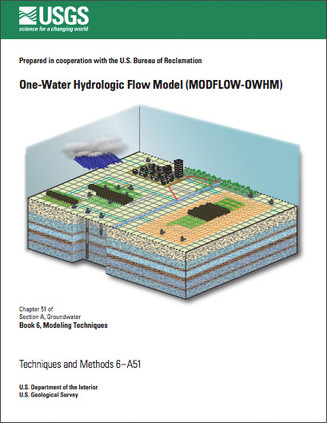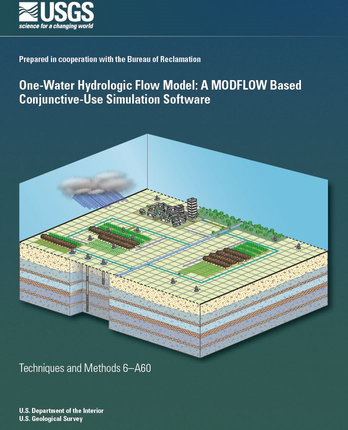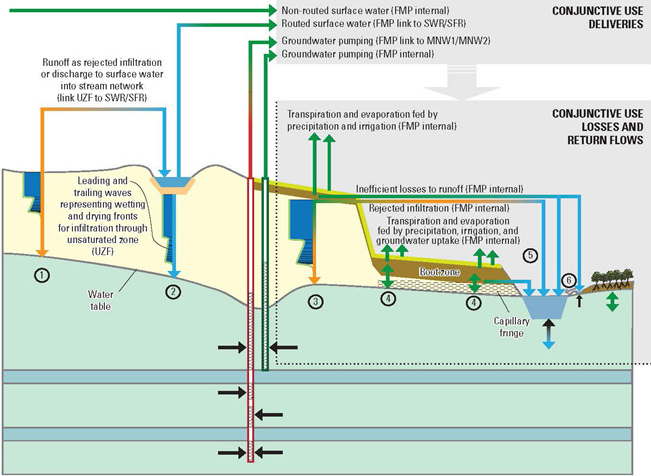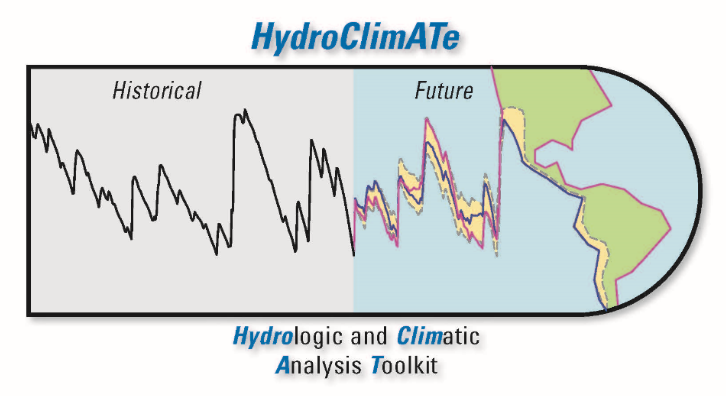Cell: (619) 379-3288 Skype: rthanson
About One-Water Hydrologic
One-Water Hydrologic provides services for analysis or training in the use of integrated hydrologic models and other analysis tools related to hydrology and climate change/variability that include:
One-Water Flow Model - Version 1 (https://pubs.usgs.gov/tm/06/a51/)


The One-Water Hydrologic Flow Model (MF-OWHM or “One Water”) is a MODFLOW-based integrated hydrologic flow model (IHM). One-Water is designed for the analysis of a broad range of conjunctive-use issues. Conjunctive use is the combined use of groundwater and surface water. MF-OWHM allows the simulation, analysis, and management of human and natural water movement within a physically-based supply-and-demand framework. One Water allows the simulation of head-dependent flows, flow-dependent flows, and deformation-dependent flows that collectively affect conjunctive use and the sustainability of water resources.
One-Water Flow Model - Version 2 (https://pubs.er.usgs.gov/publication/tm6A60)

One Water is the newest, fastest, and most complete version of MODLFOW available from the USGS, that includes many new features, and all of the features from the latest versions of MF-2005, MF-NWT, MF-LGR, MF-SWR, MF-FMP2, & MF-OWHM ver.1. So you can easily run any model that uses these codes within One-Water and incrementally take advantage of the many new helpful features!! One-Water is the only version of Modflow that is specially designed for the supply-and-demand simulation of conjunctive use of land and water for development, adaptation, mitigation, and climate-change analysis
One-Water is based on MODFLOW-2005 with the Farm Process (MF-FMP2). In this second version of One-Water, the new FMP4 has many new features with more types of additional demands such as salinity leaching for irrigation and direct recharge for water banking, new data structures. FMP4 is also linked with links to reservoirs and related surface-water operations (SWO), plus links to SFR, DRT, UZF, and MNW2 Packages. One-Water now includes the ability to simulate karst aquifers with the Conduit Flow Process (CFP), and more features for error and water budget tracking. One-Water also maintains previous new features from MF-OWHM version 1 such as the Surface-Water Routing Process (SWR), Seawater Intrusion (SWI), and Riparian Evapotranspiration (RIP-ET). One Water has the most numerical solvers with all the previously available solvers from MF-2005 plus the new solvers Newton-Raphson (NWT) and the nonlinear preconditioned conjugate gradient (PCGN). One-Water includes upgrades to many of the original MF-2005 and MF-OWHM packages and easy linkages to precipitation-runoff models (ex. BCM, PRMS, VIC, and HSPF), linkage to climate-change models, and enhanced budgets accounting needed for California SGMA GSP models and transboundary agreements.

The Second Version of One Water now includes the ability to simulate karst aquifers, links to reservoirs and related surface-water operations, new FMP4 with additional demands such as salinity leaching for irrigation and direct recharge for water banking, new data structures, and more features for a self-updating model structure.

HydroClimate Toolkit
The possible effects of climate variability and change have been identified as major issues for the sustainability and availability of the water resources of the United States. In order to improve our understanding of the relations between climate variability and water resources, the USGS developed a toolkit that allows identifying relations between past hydrologic and climatic conditions. In some cases, these relations can be based on multiple cyclical, or reoccurring, patterns in climate that can have global effects. By improving our understanding of how hydrologic systems can vary with climate, hydrologic models and management of water resources, can be improved by including the effects of climate variability in long-term projections of water availability and assessing management periods aligned with climate cycles. Hydrologists and water managers can use this new software to assess these effects as well as make statistically-based projections of how climate may affect water resources in the future.

- GUI based toolkit that helps identify responses of hydrologic systems to climate variability
- Quantifies statistical relations between multiple time series and known climate indices
- Projects hydrologic time series using time-series models and spectral analysis for assigning groundwater model boundary conditions and calibration targets
- Estimates Empirical Orthogonal Functions (EOFs) between different climates or other spatial arrays
- Toolkit Capabilities Include: Data Transformations/Linkages, Fourier Analysis, Maximum Entropy Method, Spectral Analysis, EOFs, Linear Reg/Correlations/Lags, & ARMA Projections from Reconstructed Cyclic Components of time-series signals.
- Use climate cycles to plan operational activities (interannual), new development/sustainability policies Interannual-interdecadal), climate change (multi-decadal)
History
The company founder, Randall Hanson, was a lead MODFLOW developer as a U.S. Geological Survey research hydrologist for over 38 years developing hydrologic methods and water-supply analysis of regional watersheds nationally and internationally. His research includes development of the integrated hydrologic model, MODFLOW-One Water, for conjunctive-use, climate-change adaptation, and sustainability analysis; climate analysis, and regional watershed analsysis.
"The greatest success is helping others with their success.” (MHK MTBS 2017)
